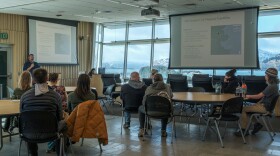Shellfish harvesters are once again being advised to use caution, after harmful algal blooms that can cause paralytic shellfish poisoning were observed at several Kodiak beaches last week.
Staff with the Kodiak Area Native Association’s Environmental team conduct weekly tests during the summer at Mission Beach, South Trident Basin and Frye Point, which is also known as Sometimes Island, in Womens Bay. On Friday, May 9, they reported a bloom of Alexandrium catenella, which produces the saxitoxin that causes paralytic shellfish poisoning or PSP, at both South Trident Basin and Mission Beach.
According to the latest data, there was also Alexandrium present at Frye Point but not at high enough levels to indicate a bloom. The water temperature at those locations last week was warmer than average for the month of May based on National Weather Service data. At Frye Point, a.k.a. Sometimes Island, it was 8 degrees Celsius, while at Mission Beach and South Trident Basin it was 7 degrees C.
Last year, KANA’s Environmental team observed blooms in Kodiak waters by the end of May and had advisories in place off and on throughout the summer.
Blue mussels and butter clams are common varieties of shellfish that are harvested around Kodiak Island and can contain PSP. Symptoms of PSP include numbness or nausea and in severe cases can lead to paralysis or death. In recent decades Kodiak has experienced PSP outbreaks at higher rates than any other region in Alaska, according to state data.
There is no state testing program for subsistence harvested shellfish, only commercially sold shellfish. But local harvesters can submit a sample of their shellfish to KANA for free PSP testing through the organization’s Harvest and Hold Program.
Contact the environmental team for more information via email at environmental@kodiakhealthcare.org or by calling 907-486-1362.





